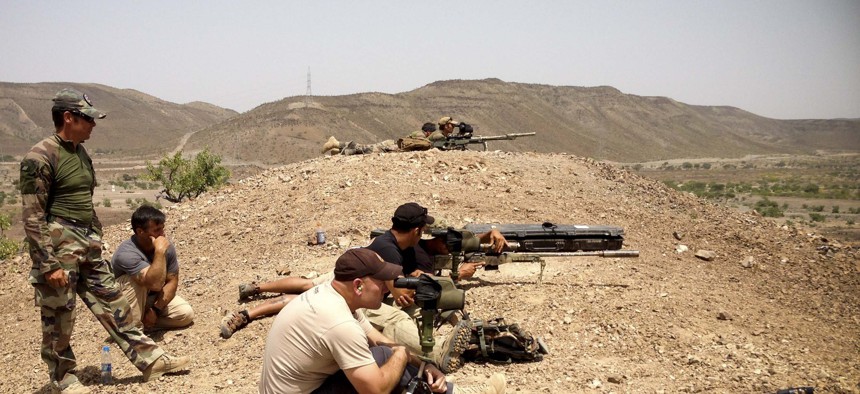
U.S. special forces and French special operations snipers train in Djibouti, May 2013. U.S. Army photo
What the Syrian Train-and-Equip Effort Could Learn from US Ops in Africa
The commander of U.S. special operators in Africa also says African warlord Joseph Kony is on the run — but he needs more authority from Congress to broaden the U.S. military’s mission in Africa.
When the U.S. special operations troops get to Syria, they might apply lessons from the experience of the roughly 1,400 special operations troops and supporters working “coffee-breath close” with partners in 23 African countries, the chief of U.S. Special Operations Command Africa said Monday.
“I think SOF operations in Africa opens up a unique opportunity to look at how we advise and assist, train and equip and conduct a full spectrum of SOF operations … to understand how to operate a lethal force that can develop effectively and operate in and among the populace,” said Brig. Gen. Donald Bolduc at the Defense One Summit in Washington, D.C.
Bolduc said U.S. special operators have had success training and equipping African security forces to face threats from Kony’s militia, the Lord’s Resistance Army; Boko Haram; al Shabaab; al Qaeda in the Islamic Maghreb; and a growing Islamic State presence.
But Africa remains “as lethal and dangerous environment as any in the world,” he said. “ISIS has a foothold in Libya, ISIS is able to co-opt and influence foreign terrorist fighters...They are a transnational threat, they are a transregional threat, as are all the threats we deal with in Africa.”
In Chad, and Cameroon, where the Obama administration recently authorized the deployment of up to 300 U.S. troops, U.S. and friendly forces are keeping Boko Haram contained, he said. But in Niger, they’re seeing more success, and are degrading the group.
As for Kony, Bolduc said his command has had a “hugely successful mission.” Their efforts have helped reduce the warlord’s militia from roughly 3,000 to less than 200, take several LRA commanders off the battlefield, and inspire another handful to give themselves up. To an extent, they’ve become a victim of their own success, he said. The next step is to broaden the mission past Kony and advising and assisting, to more training and equipping to enable local security forces to be more proactive, rather than reactive. But they’ll need additional authorities from Congress.
Bolduc said the National Security Council and Joint Staff are currently looking at that expansion. “We’re looking at that mission to rescope it in order to transition it or do something with that mission and that will require different authorities,” he said. “Because right now we have advise and assist authorities, and depending on what they ask us to do we may need train and equip authorities or something else. So we’ve been asked to give them that feedback and that assessment.”
And, of course, they could always use more resources, he said.
“Nobody ever has enough of what they need, right? So yes, we could always use more,” Bolduc said. “We take what we get.” Still, he would welcome additional intelligence, surveillance and reconnaissance resources that have more capabilities, in particular.
“Special operations forces focuses on the right people,” he said, “but not necessarily the right technology all the time.”
Bolduc also said U.S. military leaders are seeing “less and less issues that would trip the Leahy vetting problem” — referring to the U.S. law that requires the U.S. military and aid organizations to thoroughly vet any candidates or potential recipients for evidence of war crimes or human rights violations.
